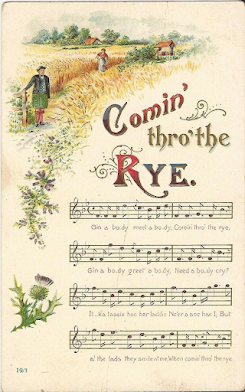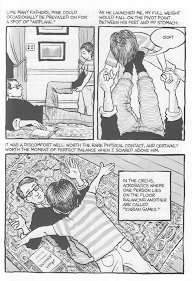Don't Listen to Buddy

When Esther spends the night with Constantine, she imagines what it would be like if they were married. She says, “ This seemed a dreary and wasted life for a girl with fifteen years of straight A’s, but I knew that’s what marriage was like” (Plath 84). She also recalls the time she was visiting the Willards when she saw a rug that Mrs. Willard had made with Mr. Willard’s old suits. Esther describes how she would have hung it on a wall to be admired, but Mrs. Willard uses it as a kitchen mat, and “in a few days it was soiled and dull and indistinguishable from any mat you could buy for under a dollar…” (85). This is a particularly important memory because it’s an insight to Esther’s perspective of marriage and the life of a housewife. For her, marriage is something that changes women for the worse. Mrs. Willard had spent weeks making this rug, and Esther says how she “admired the tweedy browns and greens and blues patterning the braid” (84). The rug represents both women and their achievements, but it also reflects the consequences of what happens to women after marriage. Like Esther, who wants to become a writer, women have the potential to pursue their creativity and individuality, yet once they get married, they become like the rug in the kitchen: “soiled and dull and indistinguishable” (85). Despite their interests, marriage classifies all women under the title of “housewife;” their identity becomes muddled and worn.
This idea of marriage is a looming presence for Esther, pushing her further under the bell jar, and in the succeeding chapter, she recalls a trip where the potential future of marriage becomes quite real. This, of course, is when Buddy Willard asks her to be “Mrs. Buddy Willard.” Esther is visiting Buddy at the sanatorium during Christmas, which leads to quite an eventful skiing trip. If Mrs. Willard’s rug represents how Esther views the idea of marriage, then this skiing incident is a scenario of what it would be like if Esther were to actually be in a traditional marriage.
Neither Buddy nor Esther have skied before, but Buddy is confident that he can teach her. After she practices on a smaller slope, he encourages Esther to try skiing from a larger hill, but she says, “But Buddy, I don’t know how to zigzag yet. All those people coming down from the top they know how to zigzag” (96). Unlike the others, including Buddy, Esther isn’t ready to fully commit to the “steep hill” of marriage; she doesn’t know how to navigate, or “zigzag,” the life of a married woman. Even though she is hesitant, she says, “it never occurred to me to say no” (96). Yet she doesn’t question this future because she recognizes that the expectations for a woman--cleaning, cooking, taking care of the husband--are just the definition of marriage, especially as she sees both her mom and Mrs. Willard doing the same for their families.
When Esther is at the top of the hill, she tries to zigzag with the others but then loses control. As she’s flying down the slope, she says, “I felt my lungs inflate with the inrush of scenery…I thought, ‘This is what it is to be happy’” (97). She has diverted from the main path, but she feels free because she has managed to ski down her own course. Alas, she crashes at the bottom, and Buddy tells her that she has broken her leg in two places. In this slippery slope of a metaphor, it seems that when Esther lets go and lets herself veer off course, it doesn’t end well, for she breaks her leg. Living the life she wants has literally obstructed her ability to move forward; it seems that society is telling her she will not be successful if she doesn’t follow the life that is expected of her.
“Every time it rained the old leg-break seemed to remember itself, and what it remembered was a dull hurt” (86). Her injury, though healed, remains a reminder to Esther of what could happen if she skis down her own path.


I really like the relation you draw between Esther and Buddy skiing down the hill and Esther's views of marriage. I thought the idea of her breaking her leg when she veers off the main path being a metaphor for her hardships of trying to steer off the beaten path of life expected for her was incredibly clever and I think you do a great job of illustrating this connection. Great post!
ReplyDeleteAwesome post! I wonder how this experience/metaphor affected Esther's coming-of-age in the long run. The wave of happiness that she feels before tumbling off track is also very interesting. Is her "rebirth" after her hospitalization just another wave of happiness? Or has she created a new path away from the steep slopes of expectation?
ReplyDeleteGreat post! I never thought of the skiing trip in this way, but it makes total sense. There is also something to be said for the fact that Buddy pushes her into skiing down a slope she isn't ready to do, and she ends up hurt because of it (much like he's trying to push her into marriage even after she rejects her proposal). Its also interesting how she's only happy when she skis down her own path, despite getting hurt doing so.
ReplyDeleteThe metaphor of the ski slope as Esther's life and views on marriage totally makes sense. She's being pushed into something she's not comfortable with by Buddy, who isn't really thinking about how she could get hurt. That's also happening at the same time with the proposal, where Buddy is kind of disregarding what Esther might want. Great post!
ReplyDeleteIt's such a perfect encapsulation of Buddy's general character--his pretense toward authority, his naive, easy-going self-confidence--that he insists he can teach Esther to ski despite never having skiied himself. He has watched some people do it, so he's pretty sure he knows all there is to know. If the contemporary concept of "mansplaining" were unclear to someone, you could do worse than point them to this chapter in _The Bell Jar_.
ReplyDeleteThe rug is also a good symbol for Esther's anxiety about marriage--it represents a form of creative ART that literally becomes a doormat in the household. I always think of Buddy confidently declaring that once she's married, Esther won't want to write poetry anymore. As if this conventional life would "cure" her of this weird disorder she has where she wants to write poems. It's as if she can imagine her poems being turned into a doormat for Buddy to wipe his feet on when he comes home.
I love the line you draw with Esther's injury and what would happen if she ever veered off course I think it explains a lot of her fear and hesitation to deny all the societal standards that keep her stuck in the bell jar.
ReplyDeleteI really liked this post! I think that the rug is such a prominent symbol for Esther because deep down she knows that she doesn't want to be the rug that has become rough and used. Instead, she wants to achieve more for herself and be her own person.
ReplyDeleteYou made a really cool connection between marriage and skiing, and I'm here for it. Esther unfortunately is pushed this way and that in an effort to get her to become a wife, and yet she feels the best and most free when she forges her own path, though that itself results in a bad situation for Esther. What Esther has hopefully learned by the end of the book is that sometimes bad things happen, and that you have to be persistent in order to secure your goals.
ReplyDelete